4-out 1-in drive and kick
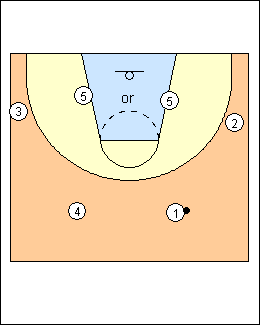 | 1 Consistent dribble penetration is difficult to defend, it forces the defence to help and recover or rotate. A system of movement on penetration allows the driver to know where his teammates will be. General principles on penetration: coachesclipboard.ca - off-ball perimeter players create a passing lane and make their defenders have to recover the greatest distance possible, staying in the eyes of the ballhandler and not allowing a three in a row. Jeff Bauer - off-ball players create as much distance from their defenders as possible, weakside players widen the drive. Alison McNeill - flatten out to the baseline if the point guard is penetrating, then look to i-cut or backcut off the penetration. Coach K - don't stay on the line of the drive, that's where the help is. Jerry Petitgoue - there should always be a guy behind the dribbler. Rick Torbett - the other players circle in the direction of the dribble, and there is always someone in the "hole", the place the penetrator just left (his bail-out). Pass ballside on one dribble, pass back on two dribbles. Heath Millar - if a player dribbles towards you, move in that direction, if he dribbles away, fill behind. Patrick Hunt, Peter Lonergan - fill two out of four receiver spots (edges of the backboard and inside the elbows), have a safety cover the point and a 3-point threat in vision opposite the ball (Lonergan - the other four players move away from the ball, receivers must move on the first bounce). Basketball Australia - on penetration into the key both baseline receiver spots should be occupied, and one of the top receiver spots. Dave Arseneault - we emphasize dribble penetration then the kickback for a three-pointer, and have found that the position directly behind the penetrator is the ideal spot for the shot. Basketball NSW - a cut that is made toward the basket creates space behind for a second cutter, or for the ballhandler to "drive on the back of the cutter". |
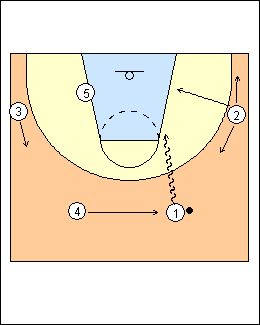 | 2 1) Outside drive from the slot a) weakside low post - if X2 helps across, or opens up to defend a backcut, 2 fills behind (kickup or curl) - if X2 helps uphill or denies, 2 backcuts (unless 1 drives deep), or slides to the corner if a shooter (kickdown) - 3 gets in vision - 5 cleans up, pivoting to face the basket - 4 fills behind. Lawrence Frank - if X2 helps across, 2 rotates up behind 1 who can pass back then go to the corner - if X2 helps up, 2 can backcut, or stay in the corner if a shooter; if 1 passes to 2 in the corner, 1 has to cut and clear weakside and is replaced by 4 - 5 moves low to find a gap, 3 has to move up in vision (if X2 stays home, X5 has to help on 1, and X3 has to help the helper) - on penetration from the top with two low posts, 4 and 5 get their heels to the baseline in an open gap. coachesclipboard.ca - 2 will i-cut (his defender helps downhill), slide along the arc (his defender helps uphill), or backcut (his defender helps uphill and loses vision) - weakside 3 and 4 widen the drive - weakside 5 dives to the basket and seals up - a weakside high post would basket cut. Lonergan - 2 can lift, or slide to the corner if his defender helps uphill. Torbett - 1 often can't beat his check and X2 stays as 2 slides (does not help), so 2 looks to reverse direction (curl behind), especially when the passer is in trouble. Vance Walberg - 2 backcuts, or kicks up if X2 opens up, weakside 5 cleans up. If 1 gets deep (in the drag zone), eliminate the 2, 3 is tough, reverse pivot, pass to 4 dragging behind. Avery Johnson - 4 is pressure release if 1 gets trapped. Hunt - 5 and 2 fill bottom receiver spots, 4 fills behind 1, 3 works in space, in the eyes of the penetrator. John Calipari - 4 fills behind, 3 lifts weakside as soon as 1 starts to go, his man is going to help in, 5 looks to seal him in for a pass to 3, if X3 doesn't help in, look for a lob pass to 5. Ballside 2 comes one step out of the dead corner. |
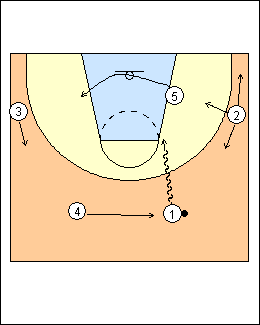 | 3 b) ballside low post - 5 relocates to the other side (opening up a backcut option for 2) coachesclipboard.ca a) ballside 5 steps out, seals up, or curls underneath the basket b) the most effective movement for low-post players is to circle under the basket when a driver comes through the middle 1/3 of the floor directly at them. Vance Walberg - ballside 5 relocates (circling under the basket to the other side, leaving an open lane). |
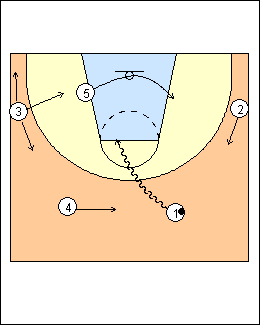 | 4 2) Middle drive from the slot a) weakside low post - 4 fills behind (kickback) - 3 kicks up, backcuts, or kicks down (if a shooter) - 5 relocates (allowing a backcut option) - 2 moves up in vision. Walberg - 4 comes behind 1 (kickback), 2 moves up a big step out of the (deep) corner, 5 relocates, 3 backcuts or kicks up. coachesclipboard.ca a) - 4 fills behind - 3 slides baseline along the arc, or can backcut with no weakside low post and his defender loses sight - 2 slides baseline (widens the drive) - 5 steps out along the baseline, seals up, or curls underneath the basket - a weakside high post would basket cut. b) - 5 circles under the basket. Lonergan - 2 lifts on penetration away from the ballside wing, 4 can space for a shot or dive to the rim, the last player opposite the penetration must fill the dead corner. No three-in-a-row, don't move in behind another receiver or a defender. Hunt - 4 fills behind. John Calipari - 4 comes behind, the corners play opposite each other, ballside 3 comes one step out of the corner (they are trying to keep his defender buried in the corner), weakside 2 comes up automatically, 5 gets to the other side of the rim (starting with a crossover step), or can push back for a shot if no one is in the corner. Dave Leitao - loop - on a middle drive from the wing or the top, a teammate comes behind, if the ballhandler gets to help defence (two guys guarding the ball), he will jump stop and reverse pivot. |
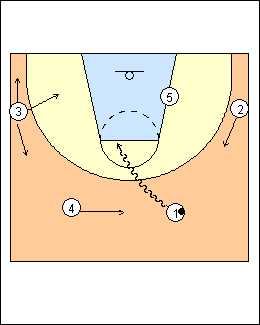 | 5 b) ballside low post - 5 cleans up. Walberg - 5 cleans up. coachesclipboard.ca - 5 steps out along the baseline, seals up, or curls underneath the basket. - 3 slides baseline along the arc, or can backcut if his defender loses sight (and with no weakside low post). |
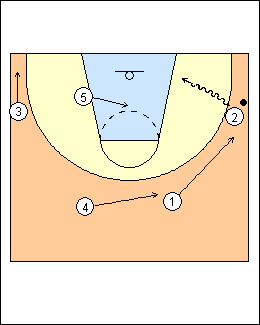 | 6 3) Baseline drive from the wing a) weakside low post - 1 fills behind (dots the i) - 4 gets in vision, filling behind 1 (avoiding a three-in-a-row with 5) - 3 drifts baseline - 5 cuts to the dots coachesclipboard.ca - 4 widens the drive to 45 - 5 steps quickly to the bottom of the circle or seals up against a defender rotating down. Bauer - 5 "pipe cuts" up the middle of the lane, sealing any defender Walberg - 1 drags behind 2, 5 tees up below the nail, 3 is in the corner, 4 finds an open window (Walberg shows ballside). Torbett - for passing angles on baseline penetration fill four positions, drift (opposite corner), 45 degrees (opposite elbow), 90 degrees (ballside elbow), and safety behind the ball. Jay Wright - 5 to the dotted line, 3 rim extended, closest man fills behind, always fill the point. The looks are 5, baseline, top, behind. Rick Majerus - on an empty-post baseline drive, 1 cuts behind for a crackback, 4 drifts to vision (can the driver see me), 3 sprints to the corner for drift (a bounce pass), 5 diagonals to the front of the rim for a chest (not bounce) pass. Tom Crean - always be in the slot on a baseline drift pass, it's the most open shot in the game. Hunt - 5 fills the bottom weakside receiver spot, 1 fills the top ballside spot, 4 fills behind 1, 3 works in space. Leitao - crackback and fade - there is a crackback by 1 and 3 fades into the corner. Try to fill opposite the ball. The drive by 2 takes away 1's ability to be a cutter, he has to see that. If you are in the middle of a cut, try to get to spots on a drive. If two guys are going to the same spot, just talk. John Calipari - it's conventional basketball, 5 goes to the broken line, 1 fills behind, there's a skip pass to 4 over the top (weakside slot). Andy Sparks - 2 uses a right-left one-two stop if the drive is cut off, forward pivots on his right foot looking to pass or to reverse pivot, keep X2 on his back, and shoot (like a dribble out and back move). |
 | 7 b) ballside low post - 5 i-cuts two steps up the lane - 4 widens the drive to 45. coachesclipboard.ca - 4 widens the drive to 45 or dives to the basket if his defender loses sight. Bauer - 5 can circle cut behind 2, or drop and hop (drop step the foot being driven at, hop off both feet to an open area), or i-cut (cross-step with the baseline foot, cross-step again). Bill Self - a ballside low post uses a cross-step, cross-step, reverse pivot to empty the post on penetration from the wing. Walberg - he does not want baseline penetration with a ballside low post, the defence will trap it. Majerus - ballside 5 (occupied post) makes space by lifting the foot closest to driver 2 and runs to the midpost area, curling to face 2 and calling his name for a hook pass. On a catch 5 can shoot, dribble hand-off to a perimeter player, or pass and follow to ballscreen. Perimeter players should never be afraid to drive an occupied post, it's the post's job to get out of the way. Jim Les - 3 drifts to the far corner, 5 goes to the ballside elbow, 1 fills behind (the bail-out guy), if the trailer can shoot he spots up for a 3-point shot, otherwise send him to the glass. Hunt - if 5 is a shooter he can i-cut behind the drive and two perimeter players must fill receiver spots, otherwise 5 goes to the dotted circle and another player must fill a spot (3 goes to the bottom weakside spot). Leitao - 5 gets to the middle of the floor (the dots) for a bounce pass. |
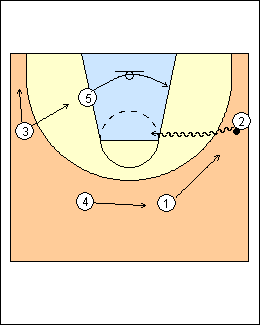 | 8 4) Middle drive from the wing a) weakside low post - 1 fills behind (kickback) - 5 relocates - 4 fills behind (or widens the drive) - 3 widens the drive or backcuts. Walberg - 5 relocates, 1 kicks back behind 2. coachesclipboard.ca a) - ballside swing 1 i-cuts when his defender helps downhill (towards the baseline) - weakside swing 4 widens the drive and slides along the arc - weakside wing 3 widens the drive - 5 can step off the lane along the baseline, seal up against a rotating defender if his defender goes to help, or circle under the basket to the other side if his defender loses vision - a weakside high post would cut to the basket. b) - 5 moves under the basket to the other side, there is usually a passing window as X5 makes a move towards 2 and loses vision of 5. Bauer - on a [middle] drive from the wing, weakside players widen the drive - space out as far as they can then slide the arc to find open areas. 1 will slide, curl, or relocate because his defender is responsible for helping. Lawrence Frank - 4 and 3 drift. Ian MacKinnon - 5 seals on the weakside block, 3 spots up. John Calipari - 1 and 4 fill behind from weakside, if 2 and 4 cross it's when the ball gets to the middle, and that's when 3 comes out of the corner to the foul-line extended, replacing 4. Leitao - loop by 1. |
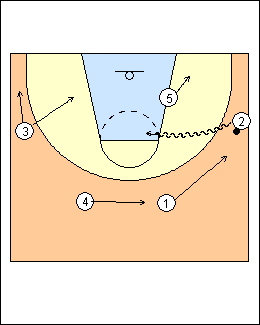 | 9 b) ballside low post - 5 cleans up or gets his heels to the baseline in a gap. Walberg - 5 cleans up. coachesclipboard.ca - 5 steps off the lane to the baseline - 3 can widen the drive or backcut if his defender loses vision. Bauer - 5 steps out on a middle drive, making a cross step with the top foot then another cross step to the short corner. Ian MacKinnon - 5 moves out to the short corner. Majerus - with an occupied post 5 again makes space by lifting the foot 2 is driving at, turns his body momentarily to head to the baseline, then turns to open and call for the ball. Hunt - 3 fills the weakside bottom spot, 5 fills the ballside bottom spot or goes to the short corner if a shooter, 1 fills behind 2, 4 spaces away. Leitao - 5 gets to the dunker spot (short corner) with his rear end to the baseline. |
This page was made with Basketball playbook from Jes-Soft